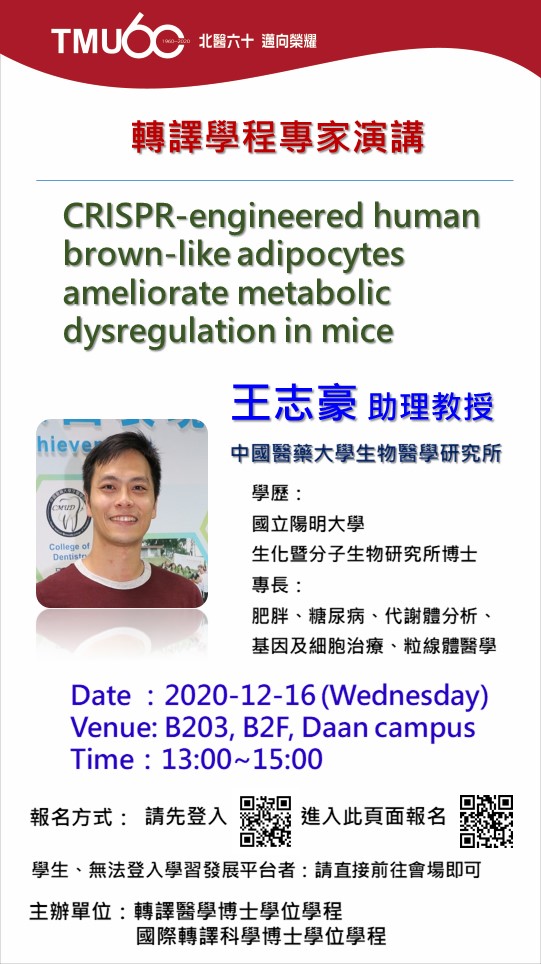敬邀參加109年12月16日(W3) 轉譯學程專家演講 王志豪 助理教授
敬邀參加109年12月16日(W3) 轉譯學程專家演講
主講人:王志豪 助理教授
講 題:CRISPR engineered human brown like adipocytes ameliorate metabolic dysregulation in mice
時 間:109年12月16日(W3) 13:00~15:00
地 點:大安校區 B2 B203會議室
報名方式:
1.北醫教職員:
進入此頁面報名
2.學生、無法登入學習發展平台者:請直接前往會場即可
誠摯邀請本校教師與同仁們撥冗參與!

Special Lecture
Speaker: Chih-Hao Wang (Assistant Professor)
Date :2020-12-16 (Wednesday)
Venue: B203, B2F, Daan campus
Time:13:00~15:00
Language:English
CRISPR-engineered human brown-like adipocytes ameliorate metabolic dysregulation in mice
Abstract
Brown and white fats play crucial roles in systemic energy homeostasis. Brown fat is specific for energy dissipation and has multilocular lipid droplets, while white fat is the main site for storing excess fuel containing unilocular lipid droplets. The activity and amount of brown fat are inversely correlated with body mass index in mammals, making brown fat an appealing target for anti-obesity therapies. Aiming for transforming white fat to brown fat may hold great potential in preventing or treating obesity and obesity-related metabolic disorders, since white fat is more easily reachable and manipulatable considering its abundance and location. Uncoupling protein 1 (UCP1) is uniquely expressed in brown adipocytes and facilitates fuel utilization and energy expenditure. Here, we utilized the CRISPR/Cas9 synergistic activation mediator and specific gRNAs to boost endogenous UCP1 expression in human white adipocytes. The CRISPR/Cas9 engineered human brown fat-like (HUMBLE) cells had acquired human brown fat features when comparing bona fide human brown adipocytes derived from the same individual. Obese mice that received HUMBLE cell transplants showed lower body weight, a sustained improvement in glucose tolerance and insulin sensitivity, as well as increased energy expenditure. Mechanistically, increased arginine/nitric oxide (NO) metabolism in HUMBLE adipocytes promoted the production of NO that was carried by S-nitrosothiols and nitrite in red blood cells to activate endogenous brown fat and improved glucose homeostasis in recipient animals. Taken together, these data demonstrate the utility of using CRISPR/Cas9 technology to engineer human white adipocytes to display brown fat-like phenotypes and may open up cell-based therapeutic opportunities to combat obesity and diabetes.






